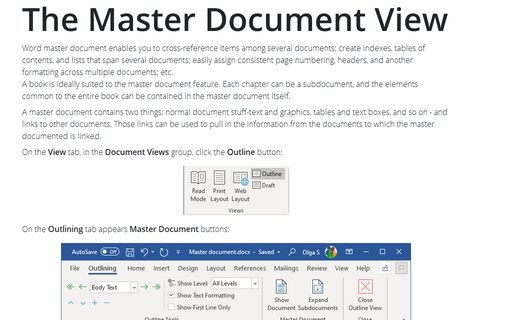Accessing document areas using the Document Map
To use the Document Map effectively, your document must be formatted with built-in heading styles or outline-level paragraph formats. If your document doesn't use either of these built-in formatting settings, Word attempts to identify paragraphs that seem to be headings and displays them in the Document Map, but this approach is only nominally effective. To navigate through a document using the Document Map, follow these steps:
1. On the View tab, in the Show/Hide group, check the Document Map checkbox:

By default, all levels of headings are visible. To change the default setting, click the plus [+] and minus [-] signs before headings with subheadings to expand and collapse sections.

2. Click a heading to jump to the corresponding section in the document window. The current section's heading is highlighted, so you can quickly see the current position of the insertion point within the document.
3. Close the Document Map by uncheck the Document Map checkbox or double-clicking the Document Map's resize bar (the bar adjacent to the vertical scroll bar).
You can format the text in the Document Map to make it easier to work with. For example, changing the font and font size can make the Document Map text easier to read and headings easier to find. (When you reformat the Document Map text, you do not alter the actual heading styles in the document.) To modify the Document Map text, follow these steps:
1. Display the Document Map pane by checking the Document Map checkbox on the View tab, in the Show/Hide group.
2. On the Home tab, in the Styles group, click the dialog box launcher:

3. In the Styles pane, choose the Document Map style and then right-click in it and choose Modify...:

Configure the font style and size, and then click OK.
You can resize the Document Map by dragging the right edge of the Document Map pane.


